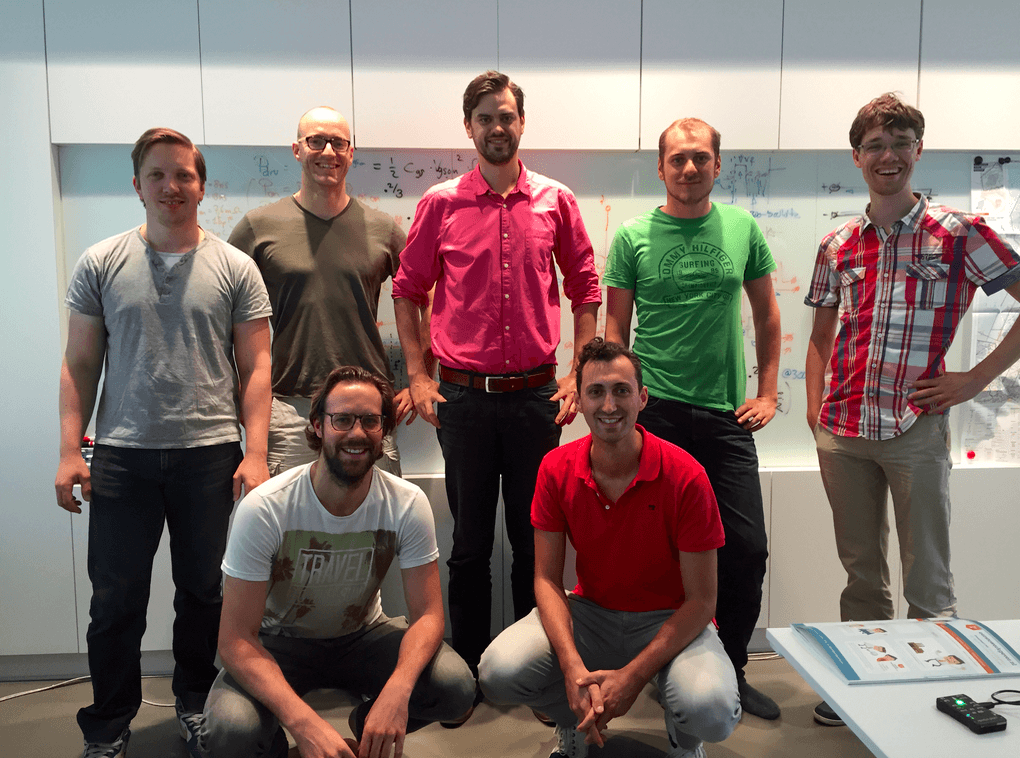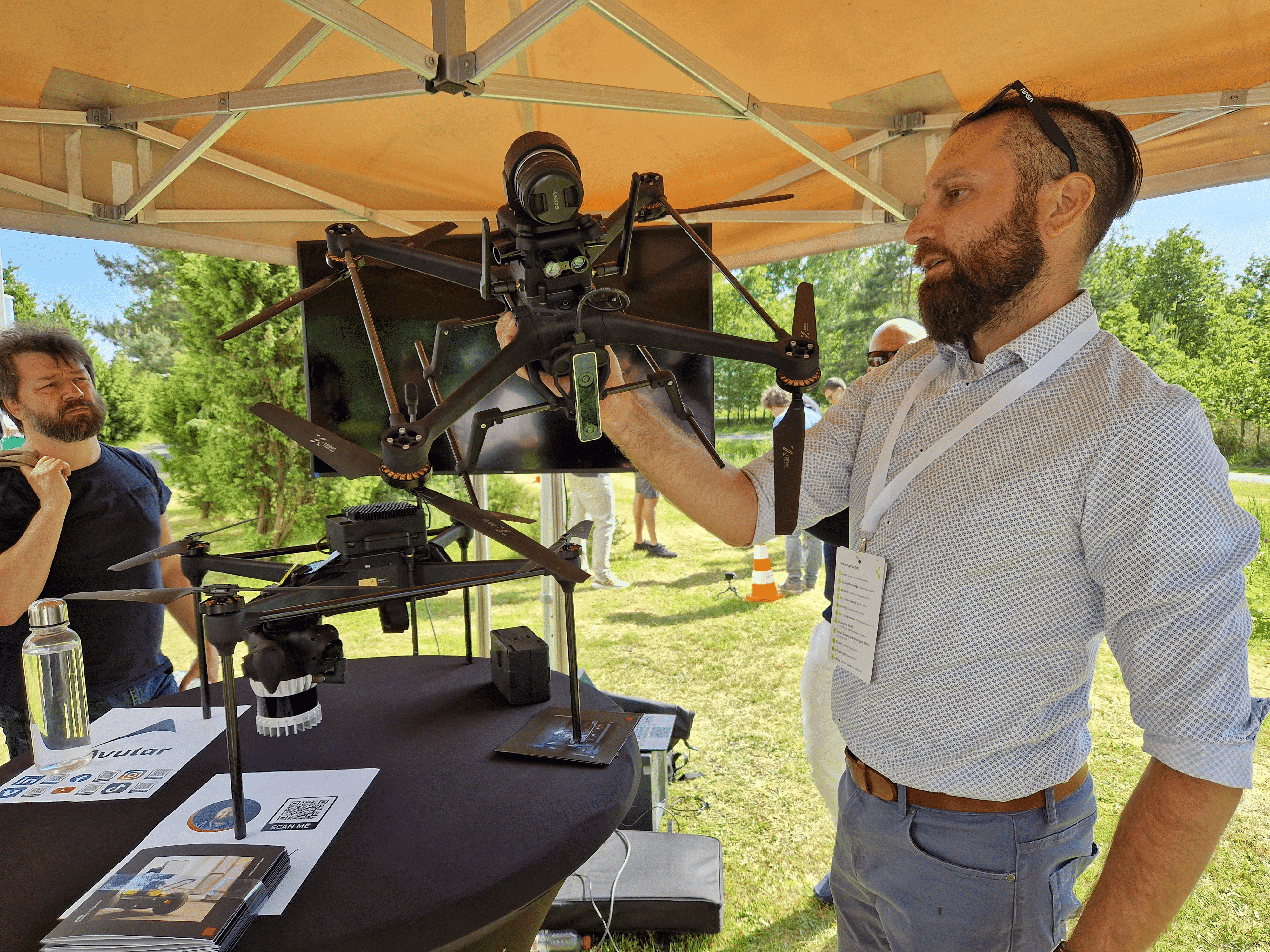
It’s clear as soon as we arrive. Two jackets on the coat rack, a bag and a drone. Today we’re with Avular, one of the start-ups from this year’s Top 10 Start-ups to Watch. Six men are working hard behind big screens in Philips’ former Lighting Application Centre (LAC). Avular is developing a new type of drone that is safe and robust enough to inspect tanks, for example.
We’re talking to co-founder Ramon Haken about the new drone regulations, flying into a tank and that special day in February: “Every time I drive past the Evoluon, I think: that was the strangest day of my life.”
A drone that flies with the precision of an ASML machine (According to the e52 jury)
The drone
Haken informs us that the drone hanging from the coat rack at the entrance isn’t the ‘real drone’. This prototype came out of a 3D printer in April to be used to give demonstrations. They  took it to Maintenance NEXT, the trade fair for maintenance professionals in Rotterdam. There is a lot of interest in the drone from this part of the industry. Avular is now collaborating with a client of the technical service provider, Cofely. The goal: to carry out the first inspections both around and inside tanks, to see if there are any leaks, for instance, by the end of the year.
took it to Maintenance NEXT, the trade fair for maintenance professionals in Rotterdam. There is a lot of interest in the drone from this part of the industry. Avular is now collaborating with a client of the technical service provider, Cofely. The goal: to carry out the first inspections both around and inside tanks, to see if there are any leaks, for instance, by the end of the year.
Avular is clearly making a drone that is stable (it can withstand a gust of wind), that is safe (there is no risk of explosion during the inspections of the oil tanks) and flies with a great deal of precision. To achieve this last characteristic, Avular is using a technology based on the same principle that ensures the precise movements of ASML chip machines. The drone incorporates a visual and a thermal camera which collect data. Avular also addresses maintenance concerns by making sure all future users are properly trained.
The regulations
The more drones in the air, the more regulations there are for their use. There is already a lot of uncertainty, but what is for sure is that commercial drone users no longer need a permit or to request permission to use drones under 4 kilos in weight. How heavy are the Avular drones? “They are under 4 kilos. But that’s not so much down to regulations as it is to market demand.” This type of drone will soon be subjected to stricter safety requirements. [expand title=””] A drone may not fly higher than 50 metres, it must remain a minimum distance of 50 metres away from groups and buildings, and it may not fly further that 100 metres away from the operator.[/expand]
The highlight
Haken and the two other Avular co-founders (Gerbert van de Ven and Albert Maas) met by chance during the Startupweekend in Eindhoven. Everything clicked pretty quickly after the idea of the drone was born. The first highlight was taking part in Startupbootcamp, the intensive three-month programme at the High Tech Campus,  which allows you to work on your company. The biggest highlight was the closing. On 6 February, the eleven Startupbootcamp participants pitched their product to investors and other interested parties in a completely full Evoluon. Avular were a great success during this demoday and caught the attention of Chinese investor Yu Ming Fang. On 19 April, Avular signed an agreement for 450,000 Euros with Yu in China. Haken thinks back to that day: “Demoday was a real turning point for us. Every time I drive past the Evoluon, I think: that really was the strangest day of my life.”
which allows you to work on your company. The biggest highlight was the closing. On 6 February, the eleven Startupbootcamp participants pitched their product to investors and other interested parties in a completely full Evoluon. Avular were a great success during this demoday and caught the attention of Chinese investor Yu Ming Fang. On 19 April, Avular signed an agreement for 450,000 Euros with Yu in China. Haken thinks back to that day: “Demoday was a real turning point for us. Every time I drive past the Evoluon, I think: that really was the strangest day of my life.”
Read about how the deal with the Chinese investor came to pass here.
The lesson learned
“The most important step that we have taken so far has been finding our focus. In the beginning you talk to a lot of people and you consider different uses, ranging from the inspection of oil tanks to crop inspections in the agricultural sector. Agriculture is still an important application, but one for the longterm because it depends on the growing seasons, for example. At one point we said that we would first work on very precise inspections in the industry. Think inspecting tanks for cracks. Today this is usually still done with scaffolding, which costs a lot of time and money. It’s great that we can focus on that now. The investment we received helps. We started with individual assignments. Now we have the space to fully focus on the drone and the means to buy the right parts.”
The next step
“The newest version of the drone needs to be ready by the end of September. That’s the deadline we set for ourselves. Our interns will go back to their studies then too,” laughs Haken. Then the tests can begin, starting indoors. “We have a large space on the High Tech Campus where we can practise safely.” The plan is for the black and yellow Avular drone to inspect its first tank at the end of the year.
This is the seventh profile of an Eindhoven start-up from this year’s Top 10 Start-ups to Watch. Read all the profiles until now:







